If you’re looking for insightful HR tech statistics to evaluate your first HR system, consider an upgrade, or pinpoint why your current platform isn’t meeting expectations, you’re in the right place. We surveyed 300 HR professionals from diverse company sizes and industries to reveal how HR technology performs in real-world situations.
This article explores the benefits of modern HR tech, statistics by company size and function, and where HR teams are experiencing the greatest impact.
Key insights
- HR technology adoption continues to rise, with 85 percent of organizations utilizing these tools to support people operations
- Modern HR tech enhances efficiency, decision-making, and company culture while simplifying compliance management
- Integration and automation remain top priorities—HR teams increasingly seek tools that connect seamlessly with existing systems, reduce manual work, and enable more strategic, analytics-driven HR practices across businesses of all sizes
Benefits of modern HR technology
HR tech has evolved significantly from the basic team member databases of the past. Today’s platforms create comprehensive ecosystems that enhance the workplace experience by:
- Helping to identify and address challenges: HR technology provides early warning systems for workforce issues that might otherwise go unnoticed until they become major problems. Advanced analytics can flag patterns like increased turnover in specific departments, declining engagement scores among remote workers, or skills gaps that may impact future projects.
- Improving efficiency and decision making: Leaders can use HR tech to access comprehensive analytics that reveal HR trends in hiring, performance, and retention. This efficiency gain allows organizations to respond quickly to changing business needs and make evidence-based decisions about workforce planning.
- Simplifying compliance management: Automated compliance tracking ensures that organizations stay current with changing labor laws, tax requirements, and industry regulations. The software can automatically calculate overtime, track required training certifications, and generate reports needed for audits or regulatory filings.
- Positively impacting company culture: Digital platforms create opportunities for recognition, feedback, and connection that strengthen company culture, particularly in distributed or hybrid work environments. Features like peer recognition systems, pulse surveys, and internal communication tools help maintain the human connections that drive engagement and belonging.
- Promoting communication: Integrated communication tools break down silos between departments and ensure that important information reaches the right people at the right time. HR tech creates channels for transparent, timely communication when announcing policy changes, sharing company updates, or facilitating cross-team collaboration.
HR tech adoption statistics
These HR software adoption statistics show which qualities teams rely on most as they scale.
1. 85 percent of organizations use HR technology to manage people operations
This high adoption rate reflects the reality that manual HR processes become unmanageable once teams grow beyond a handful of team members. Organizations using HR software can respond quickly to individual requests, maintain accurate records without manual collection, and free up their HR teams to focus on strategic initiatives rather than administrative work.
2. HR tech adoption increases as businesses scale
While 79 percent of small businesses currently use HR software, adoption jumps to around 90 percent among mid-sized companies and enterprises.
Smaller businesses often handle HR effectively with basic tools until growth reveals the limits of manual processes, like onboarding taking days rather than hours, or payroll errors becoming frequent.
3. More than half of HR professionals have used 2-3 different HR tech solutions throughout their careers
More than half of HR professionals have used two to three different HR tech solutions throughout their careers. Another 30 percent have used four to five, and nearly 10 percent have worked with six to ten.
This shows that most HR professionals know the pain of switching systems, managing multiple tools, and dealing with inconsistent data. These insights underline the importance of choosing adaptable, integrated platforms that grow with your business and reduce the need for disruptive tech changes down the line.
4. When evaluating HR tech, companies prioritize features and functionality, ease of use, and integration
Our survey found that when choosing HR software, companies most often focus on:
- Features and functionality (28 percent): Teams want tools that can solve their specific problem. Some want to streamline onboarding, while others want to automate performance reviews or improve time tracking.
- Ease of use (27 percent): Even the most powerful tools fall flat if people don’t use them. Leaders want a smooth user experience to help drive adoption.
- Integration (12 percent): HR tech needs to work with the rest of the business. Integrating with payroll, accounting, and productivity tools helps reduce duplicate work.
Recommended For Further Reading
5. When evaluating HR tech, companies rank cost, customer support, and AI capabilities lowest in buying decisions
When evaluating HR technology, companies place the lowest priority on HR software costs and customer support, both cited as key factors by just nine percent of human resources professionals. Interest in AI capabilities is even lower, with only two percent of decision-makers considering it a primary factor in their HR tech selection. This limited focus on AI may indicate that many HR teams are prioritizing essential workflow and integration improvements over advanced automation features.
It could also reflect a lack of clarity around the potential value AI can deliver or the bandwidth required to explore and implement these solutions effectively. Many organizations may wait to adopt AI-driven HR tools until they see clearer benefits or develop the internal expertise needed to leverage them fully.
6. 53 percent of HR professionals feel HR tech has significantly impacted company culture
HR tech shapes company culture in ways that extend far beyond administrative efficiency. This includes how quickly new team members feel welcomed during onboarding or how easily people can access information about career development opportunities. This makes an even bigger cultural impact for distributed teams, where technology often serves as the primary touchpoint for HR interactions and sets the tone for how supported people feel in their roles.
7. 47 percent highlighted onboarding and new hire experience as key areas improved by HR tech
A smooth onboarding experience sets expectations for everything that follows in a team member’s journey, making this one of the highest-impact areas where technology can make an immediate difference. Digital onboarding helps new joiners feel confident and supported right away, setting the tone for a strong, long-term relationship with the company.
8. 69 percent of respondents agreed that integration with other business tools is “very important” when evaluating HR platforms
HR teams no longer see their tech in isolation. They want systems that connect easily with tools across finance, IT, and operations—because disconnected platforms create data silos, duplicate work, and slow down decision-making.
Strong integration means faster workflows, better data accuracy, and more strategic alignment across teams. For modern HR leaders, it’s not just about what a platform can do on its own—it’s about how well it fits into the broader tech ecosystem.
<< Streamline HR software integration with this free checklist >>
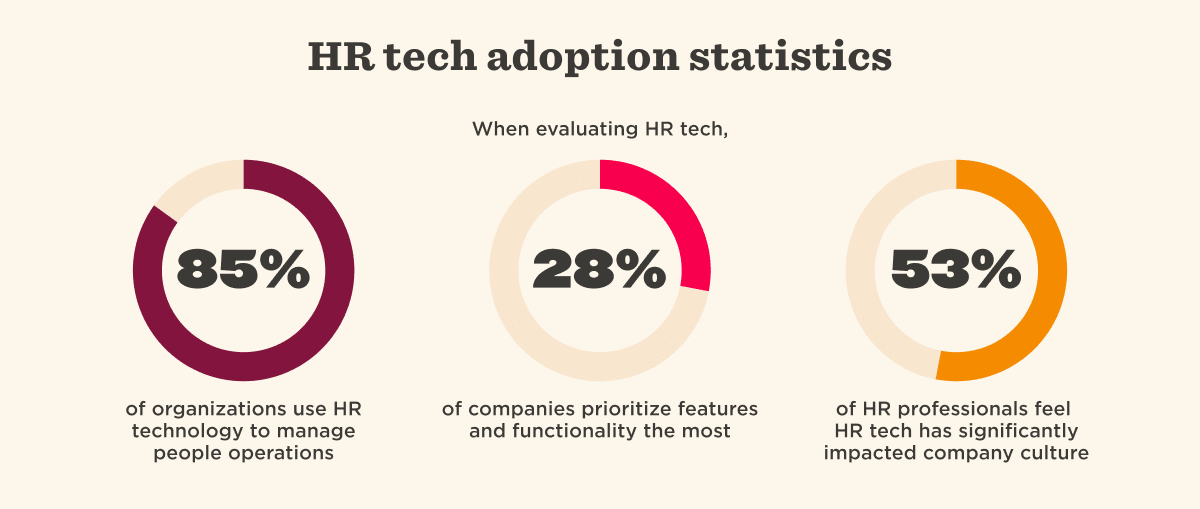
HR automation trends and statistics
As automation improves, we’re seeing it reshape how HR teams operate.
1. 18 percent cite lack of automation as one of their biggest challenges
Nearly one in five HR teams is stuck doing work that software could handle automatically, such as manually calculating overtime, transferring data between systems, or tracking vacation balances in spreadsheets. These organizations recognize that their manual processes prevent them from focusing on strategic initiatives like talent development and workforce planning.
The fact that automation gaps rank as one of their primary challenges shows how operational inefficiencies can overshadow more visible HR priorities.
2. 17 percent of HR teams rank automating manual processes as their top priority in the next 12 months
Automation tools help lean HR teams manage more work with less headcount. You can streamline time-consuming tasks like collecting onboarding paperwork, managing time-off approvals, sending payroll reports, or tracking compliance deadlines.
Organizations prioritizing automation are positioning themselves to handle growth without proportionally expanding their administrative workload. This frees HR teams to focus on being present for people who need guidance or hands-on support.
3. 21 percent of HR teams say improving data and analytics is their top priority in the next 12 months
Data and HR analytics ranking as the top priority signals that many HR teams want to move beyond “gut-feeling” decisions to evidence-based strategies. Better analytics allow teams to identify turnover patterns before they become critical, optimize hiring processes based on actual performance data, and demonstrate ROI of HR initiatives with concrete metrics. This also represents a shift from HR as administrative support to HR as a strategic business partner that influences broader organizational outcomes.
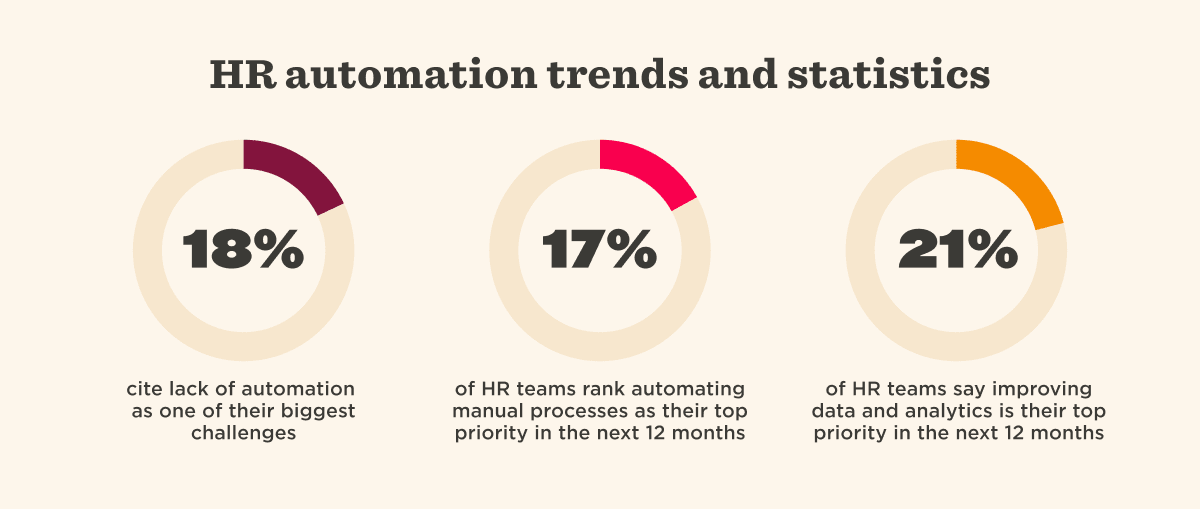
HR tech statistics in smaller businesses
Small businesses adopt HR software to save time and stay compliant as they grow. These stats show how lean HR teams view their tech.
1. 77 percent of small businesses have 5 or fewer HR professionals
Work can pile up quickly when smaller teams are handling HR for over 50 people while also managing other business functions. HR tech for small businesses becomes the best way to scale their impact without burning out.
2. 66 percent of small businesses are satisfied with their current HR tech
This satisfaction rate suggests that small businesses often have simpler expectations than their larger counterparts. They typically need core functionality that works reliably rather than advanced features they’ll never use, making it easier to find solutions that meet their actual needs.
However, the remaining 34 percent who aren’t satisfied likely represent growing companies starting to outgrow basic tools or experiencing pain points that indicate they’re ready for more advanced systems.
3. 25 percent of small businesses rank growth as their top HR priority
Growth is the ultimate goal for most small businesses, but it also creates the biggest operational challenges for lean HR teams. Companies prioritizing growth need systems that can handle rapid hiring, streamlined onboarding for multiple new joiners, and processes that don’t break down when headcount increases.
This focus on growth readiness explains why small businesses often invest in HR technology before they feel “big enough” to prepare for the scaling challenges they know are coming.
4. The biggest HR tech challenges for small businesses include ease of use, features options, and managing data spread
For small businesses, the biggest HR technology challenge is ease of use, with nearly a third of teams (31 percent) naming this as their top concern. Limited features come next, cited by 25 percent, followed closely by the difficulty of managing data spread across different tools at 24 percent.
Juggling multiple responsibilities means HR teams need software that’s simple, functional, and centralized. Intuitive platforms help lean teams manage multiple roles and get started fast. The right feature set eliminates workarounds, while having all team data in one place makes it easier to answer questions or find information.
5. 31 percent of small businesses value ease of use most when buying HR tech
Ease of use ranks highest among HR tech priorities for small businesses, ahead of features and functionality (25 percent) and cost (12 percent). Small teams typically don’t have dedicated IT support or time for lengthy training sessions.
They rely on intuitive tools that work immediately. When the same team member manages HR alongside payroll, operations, or admin, there’s no space for steep learning curves.
<< Learn how to choose the best HR software for your small business. >>
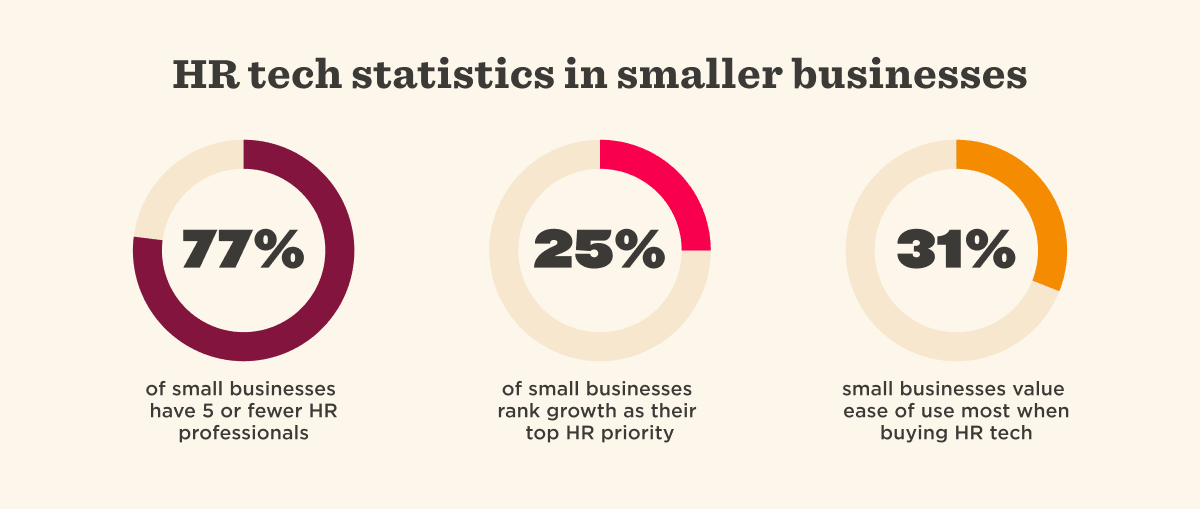
HR tech statistics in mid-sized businesses
As companies scale, HR tools become more important for managing complexity across departments, locations, and roles. Let’s look at how mid-market teams are using HR platforms.
1. 75 percent of mid-market companies are satisfied with their HR tech
Mid-sized businesses often have the resources to invest in better platforms and the agility to implement them without the roadblocks that can slow down larger enterprises. They’re able to choose tools that fit their culture, workflows, and growth plans. This strong satisfaction rate reflects how mid-market companies are using HR tech to support both people and performance with fewer compromises.
2. 22 percent of mid-market companies prioritize automation as their top HR priority
As mid-sized companies grow, automation can help scale HR output without overloading the team. Automating tasks like payroll, onboarding, and performance reviews helps HR stay focused on strategy. Prioritizing automation reflects how these companies are preparing to support even more people as they grow.
3. 25 percent of mid-market companies struggle most with integration issues
Mid-sized businesses often juggle multiple business systems—like accounting, project management, and HR—that don’t talk to each other. Without dedicated IT resources to build custom integrations, these teams face growing challenges as they scale.
Disconnected platforms create data silos and force professionals to manage information in multiple places. As companies grow, the workarounds that worked for 50 people become unmanageable for 200, making seamless integration essential to keep up with the pace of business.
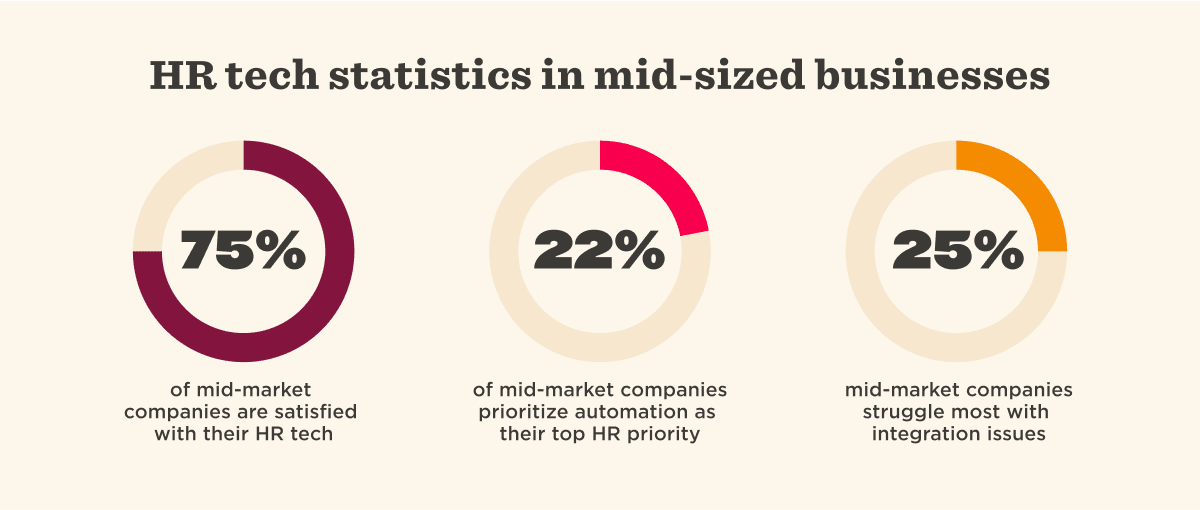
HR tech statistics in enterprises
Enterprise HR teams rely on tech to manage high volumes, maintain consistency, and support strategic goals across global workforces. These numbers show where large organizations focus their investments.
1. 25 percent of enterprises prioritize analytics as their top HR priority, followed by automation and engagement
Enterprise organizations generate massive amounts of people data to analyze and inform = decisions that can improve business outcomes. They need analytics to spot patterns across thousands of team members, predict turnover in specific departments, and prove HR’s impact to executive leadership with concrete numbers.
2. 32 percent of enterprises struggle most with integration challenges
Enterprise organizations naturally face complicated technology setups from years of acquisitions, different business units choosing their own tools, and legacy systems that can’t be replaced overnight. Luckily, these challenges are solvable with the right HR tech.
Choosing a solution with built-in integration support for payroll, performance, and productivity tools makes it easier to sync systems without custom development. The right platform improves both data accuracy and employee experience.
3. 23 percent of enterprises consider payroll their most critical HR function, followed by recruiting, and performance/talent/compensation
Enterprises often hire hundreds of people simultaneously across multiple locations. These organizations need systems that can handle complex approval workflows, maintain consistent candidate experiences across different hiring managers, and provide analytics on recruiting efficiency by department.
Enterprise HR software helps with complex scenarios like international compensation, multi-regional hiring, and multi-level approval hierarchies. Better tools become a competitive advantage when you’re fighting other large organizations for the same growth and candidates.
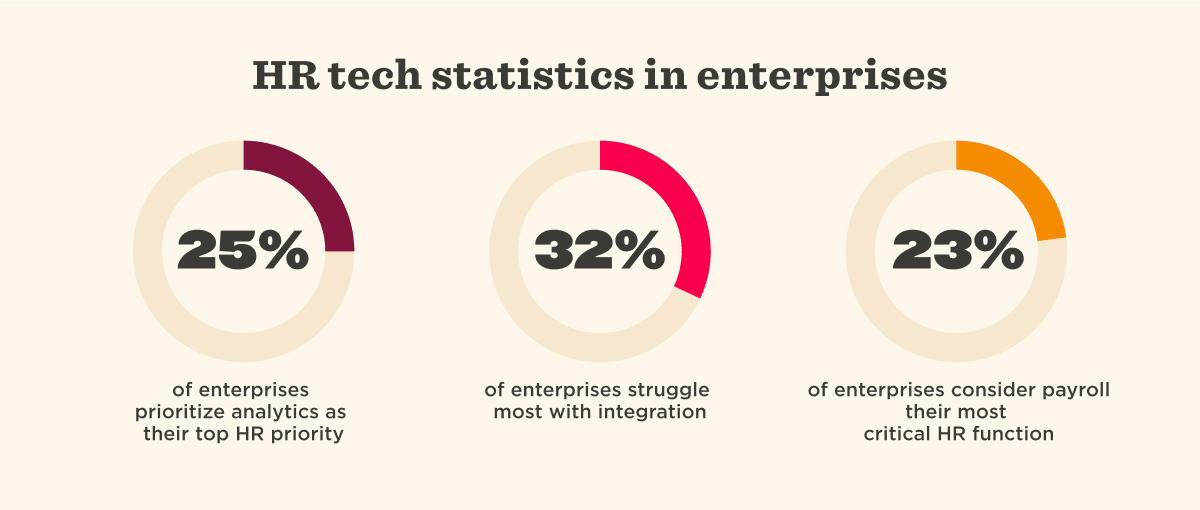
Use HR tech to empower your people
The HR tech statistics paint a clear picture: organizations that invest in the right HR technology see measurable improvements in efficiency, experience, and strategic decision-making. One of the best things you can do for your team is find a solution that matches your current needs while preparing for future growth.
<< Find the right HR platform with this free checklist. >>
HR tech statistics and trends FAQs
What is the growth rate of HR tech?
Our survey data shows that 85 percent of organizations now use HR technology. The adoption rate jumps with company size—from 79 percent among small businesses to 91 percent at the enterprise level—indicating that growth often drives technology adoption as manual processes become unsustainable. This also reflects how HR departments are moving from administrative support functions to strategic business partners that require sophisticated tools to manage complex workforce challenges.
How big is the HR tech industry?
The HR tech industry was valued at $36 billion in 2024 and is projected to reach $70 billion by 2033 as organizations invest heavily in people management systems. The market encompasses everything from basic payroll and benefits administration to advanced analytics, AI-powered recruiting, and comprehensive human capital management platforms.
What is the future of HR tech?
The future of HR tech will likely focus on deeper integration, better analytics, and more intuitive user experiences based on current adoption patterns and organizational priorities. Our data shows that only 2 percent of organizations currently prioritize AI capabilities, suggesting that while artificial intelligence will play a growing role, the immediate focus remains on solving fundamental integration and workflow challenges.
The emphasis on ease of use (27 percent) indicates that future platforms will need to balance powerful functionality with an intuitive design that requires minimal training.


